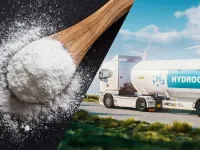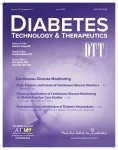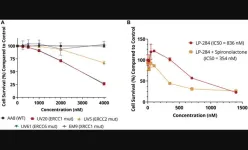(Press-News.org) In a world of continuously warmer temperatures, a growing consensus demands that energy sources have zero, or next-to-zero, carbon emissions. That means growing beyond coal, oil, and natural gas by getting more energy from renewable sources.
One of the most promising renewable energy carriers is clean hydrogen, which is produced without fossil fuels.
It’s a promising idea because the most abundant element in the universe is hydrogen, found in 75 percent of all matter. Moreover, a hydrogen molecule has two paired atoms—Gemini twins that are both non-toxic and highly combustible.
Hydrogen’s combustive potential makes it an attractive subject for energy researchers around the world.
At Pacific Northwest National Laboratory (PNNL), a team is investigating hydrogen as a medium for storing and releasing energy, largely by cracking its chemical bonds. Much of their work is linked to the Hydrogen Materials-Advanced Research consortium (HyMARC) at the Department of Energy (DOE).
Hydrogen storage not yet optimized
One PNNL research focus relates to optimizing hydrogen storage, a stubborn issue. To date, there is no completely safe, cost-effective, and energy-efficient way to store hydrogen at large scales.
PNNL researchers recently coauthored a paper that investigates a baking soda solution as a means of storing hydrogen. The study has already been dubbed a “hot paper” by the journal itself, Green Chemistry, published by the Royal Society of Chemistry. That means that it has had a lot of clicks showing interest.
The hydrogen-based storage efforts at PNNL are funded by the DOE’s Hydrogen and Fuel Cell Technologies Office in the Office of Energy Efficiency and Renewable Energy (EERE). The research advances the DOE’s H2@Scale initiative as well as the agency’s Hydrogen Shot.
The new paper’s two main authors are chemist and PNNL Laboratory Fellow Thomas Autrey and his colleague Oliver Gutiérrez, an expert in making chemical reactions speedy and cost-effective.
“You have to be a little creative,” said Autrey, who is amused at how common, cheap, and mild baking soda is as a potential answer to a big problem. “Not every chemical is going to be efficient at storing hydrogen. You have to work with what Mother Nature gives you.”
Clean hydrogen for long-term energy needs
Autrey, Gutiérrez, and others at PNNL see long-duration energy storage as the key to hydrogen’s future as a carrier of renewable energy.
Current battery technology is designed for several hours of storage. In a renewable energy grid, batteries can handle about 80 percent of storage needs.
But “the last 20 percent will take unique approaches,” said Autrey. “We will want to store the excess energy to be prepared for Dunkelflaute.”
That’s a German word describing conditions without enough solar and wind energy potential. During the dark, windless periods of Dunkelflaute, grids need a way to store energy for more than just several hours.
Seasonal storage capability like this is one of hydrogen’s attractions. So is the fact that hydrogen storage can happen anywhere―that it is “geographically agnostic,” as experts say. Hydropower, for example, requires differences in elevation to store excess water to make power. Hydrogen storage requires no special conditions related to geography.
In addition, said Autrey, as scales get larger, hydrogen gets more economical. It is cheaper to buy a few additional hydrogen storage tanks than to buy a lot of batteries.
Finding the best way for hydrogen storage
Clean hydrogen has great promise as an energy source. A process called electrolysis, for instance, can split water into hydrogen and oxygen. In the best of worlds, the power for electrolysis would come from renewable energy sources, including solar, wind, and geothermal.
However, there is one stubborn challenge: to produce hydrogen more cheaply.
To address that, in 2021 the DOE announced its Energy Earthshots initiative, a series of six steps to underwrite breakthroughs in clean-energy technology. Introduced first was the Hydrogen Shot, a quest to reduce the cost of hydrogen to from $5 to $1 per kilogram in a decade―an 80 percent reduction.
Beyond getting clean hydrogen production costs down, “you have to figure out how to move and store it,” said Autrey, which are steps that can send prices back up.
But finding the ideal medium for hydrogen storage has been elusive.
Hydrogen can be compressed into a gas, but that requires very high pressures—up to 10,000 pounds per square inch. A safe storage tank would need walls of very thick steel or expensive space-grade carbon fiber.
How about cryogenic liquid hydrogen? This is a proven storage medium but requires getting and keeping something so cold (-471 F, or -279.4 C) that peripheral energy costs are significant.
What seems to hold the most promise are molecules that are liquids, optimized to store and release hydrogen. Jamie Holladay, a sustainable energy expert, recently directed PNNL-led research on simpler and more efficient strategies for liquefying hydrogen.
Using such liquids as a storage medium have the advantage of keeping existing energy infrastructure in place, including pipelines, trucks, trains, and taker ships, said Gutierrez.
The bicarbonate-formate cycle
Want to bake cookies? Or store hydrogen energy? Baking soda could be the ticket. This mild, cheap sodium salt of bicarbonate is non-toxic and Earth-abundant.
Not baking soda exactly. The PNNL team is investigating the hydrogen energy storage properties of the long-studied bicarbonate-formate cycle. (Formate is a safe, mild liquid organic molecule.)
Here’s how it works: Solutions of formate ions (hydrogen and carbon dioxide) in water carry hydrogen based on non-corrosive alkali metal formate. The ions react with water in the presence of a catalyst. That reaction makes hydrogen and bicarbonates―the “baking soda” Autrey admires for its absence of environmental impacts.
With the right mild tweaks in pressure, the bicarbonate-formate cycle can be reversed. That provides an on-off switch for an aqueous solution that can alternately store or release hydrogen.
Before baking soda, the PNNL hydrogen storage team looked at ethanol as a liquid organic hydrogen carrier, the industry’s blanket term for storage and transport media. In tandem, they developed a catalyst that releases the hydrogen.
Catalysts are designer additives that speed the processes used to make and break chemical bonds in an energy-efficient way.
In May 2023, for a project related to the PNNL effort, EERE granted OCOchem of Richland, Washington, $2.5 million in funding over two years to develop an electrochemical process that makes formate and formic acid from carbon dioxide. The process would bind carbon dioxide with the hydrogen located in water’s iconic chemical bond, H2O.
In a partnership just starting, PNNL will develop ways to release hydrogen from the OCOchem products.
Hydrogen storage that ‘looks like water’
In the world of hydrogen storage research, the bicarbonate-formate cycle has created a buzz for quite some time. After all, it is based on materials that are abundant, non-flammable, and non-toxic.
The cycle is built on an aqueous storage solution so mild it “looks like water,” said Autrey. “You can put out a fire with it.”
But for formate-bicarbonate salts to become a viable means of storing hydrogen energy, researchers must still develop economically feasible scenarios. So far, the technology stores hydrogen at only 20 kilograms per cubic meter, compared to liquid hydrogen’s industry standard of 70.
More fundamentally, said Autrey, researchers need a systems-level understanding of the required electrochemistry and catalysis. In engineering terms, to date, the idea of a workable bicarbonate-formate cycle has a low technical readiness level.
“If we solve the catalysis problems,” he added, “we could get some real interest.”
‘An amazing shiny thing’
On the plus side, the salt solutions under consideration at PNNL release hydrogen upon reaction with water. They also operate at moderate temperatures and low pressures.
In theory, at least, as Autrey and Gutiérrez describe in their 2023 paper, the bicarbonate-formate cycle represents “a feasible green alternative for storing and transporting energy” from hydrogen.
The baking soda idea is also at the nexus of what the 2023 paper calls “several urgent scientific challenges.”
Among them are how to make a hydrogen storage media from captured excess carbon dioxide. And even to use the same media to store electrons, which offers the promise of direct formate fuel cells.
In addition, the PNNL work could provide insights for catalysis in the aqueous (water) phase. For now, the PNNL team is using palladium as their candidate catalyst. Their efforts include finding ways to make the rare metal more stable, reusable, and longer-lived.
In all, the baking soda idea “is this amazing shiny thing” for hydrogen storage, said Autrey. “What’s exciting are the possibilities.”
END
A baking soda solution for clean hydrogen storage
PNNL scientists investigate the promising properties of a common, Earth-abundant salt
2023-06-13
ELSE PRESS RELEASES FROM THIS DATE:
Can this medication reverse MS? Brain biomarker shows it can
2023-06-13
A decade after UC San Francisco scientists identified an over-the-counter antihistamine as a treatment for multiple sclerosis, researchers have developed an approach to measure the drug’s effectiveness in repairing the brain, making it possible to also assess future therapies for the devastating disorder.
The researchers, led by physician-scientist Ari Green, MD, who together with neuroscientist Jonah Chan, PhD, first identified clemastine as a potential MS therapy, used MRI scans to study the drug’s impact on the brain of 50 participants in a clinical study.
In MS, patients lose myelin, the protective insulation around ...
The advances and promise of continuous glucose monitoring in diabetes management
2023-06-13
As adoption of Continuous Glucose Monitoring (CGM) continues to increase, there is a growing body of evidence supporting the use of this technology in improving diabetes outcomes for patients with Type 1 or Type 2 Diabetes. A new supplement in the peer-reviewed journal Diabetes Technology & Therapeutics (DTT) provides an excellent perspective of the past, present, and future of CGM. Click here to read the supplement now.
In the supplement Rickson et al. review the rapid pace in which diabetes technology has progressed and the implications for relying on rigorous and extensive timelines to publish randomized controlled trials to impact ...
Ochsner Health names new chief financial officer and treasurer
2023-06-13
NEW ORLEANS, La. – Ochsner Health has named Jim Molloy as the organization’s next Executive Vice President, Chief Financial Officer and Treasurer. A leader at Citi bringing decades of extensive experience in healthcare finance, Molloy will oversee the organization’s accounting, financial planning and analysis, reimbursement and revenue cycle functions, as well as managed care contracting and treasury. He will also play a pivotal role in the continued development and execution of ...
Low birthweight is independently linked to increased risk of type 2 diabetes, and a particular presentation including lower age at diagnosis
2023-06-13
T2D patients with lower birthweight also show higher use of diabetes drugs than those with normal birthweight, and a larger number of comorbidities including high blood pressure, at the time of diagnosis.
The first study is by Dr Rasmus Wibaek, Steno Diabetes Center Copenhagen, Herlev, Denmark, and Dr Allan Vaag, Steno Diabetes Center Copenhagen, and also Lund University, Malmö, Sweden, and colleagues.
This study included adults aged 30–60 years enrolled in the Danish Inter99 cohort in 1999–2001 (baseline examination), with information on birthweight from original birth records from 1939–1971 and without diabetes at baseline. Birth records were linked ...
Gentle cleansers kill viruses as effectively as harsh soaps, study finds
2023-06-13
Gentle cleansers are just as effective in killing viruses – including coronavirus – as harsh soaps, according to a new study from scientists at the University of Sheffield
Healthcare professionals often substitute alcohol-based hand sanitisers and harsh soaps for skin-friendly cleansers in order to treat or prevent irritant contact dermatitis, which develops when chemical or physical agents damage the skin surface faster than the skin can repair
Incidence and severity of irritant contact dermatitis increased from 20 per cent to 80 per cent amongst healthcare professionals during the Covid-19 pandemic
Researchers also found non-enveloped ...
LP-284 targets non-Hodgkin's lymphoma and DNA damage repair deficiency
2023-06-12
“[...] we demonstrated the new acylfulvene compound LP-284 has anti-tumor activity including nanomolar potency in fifteen in vitro NHL cell lines and in vivo preclinical NHL models.”
BUFFALO, NY- June 12, 2023 – A new research paper was published in Oncotarget's Volume 14 on June 12, 2023, entitled, “LP-284, a small molecule acylfulvene, exerts potent antitumor activity in preclinical non-Hodgkin's lymphoma models and in cells deficient in DNA damage repair.”
Despite advances in therapies treating non-Hodgkin’s ...
Damon Runyon Cancer Research Foundation announces three recipients of 2023 Physician-Scientist Training Award
2023-06-12
Three scientists with exceptional promise and novel approaches to fighting cancer have been named the 2023 recipients of the Damon Runyon Physician-Scientist Training Award. The awardees were selected through a highly competitive and rigorous process by a scientific committee comprised of leading cancer researchers who are themselves physician-scientists.
Physician-scientists are uniquely positioned to translate scientific discoveries into therapies that improve and prolong the lives of their patients. However, ...
Where there’s smoke are lessons in demands of global sustainability
2023-06-12
As the world struggles for sustainability in the face of climate change, wildfire smoke becomes a lesson in how people can become victims far from the root of a problem and far from their control.
In this month’s open access National Science Review, Jianguo “Jack” Liu, MSU Rachel Carson Chair in Sustainability, makes a case for the world to shake off the constraints of traditional governance, which tends to address issues in one place without considering how people or ecologies near and far might be impacted.
Justice at a global scale can be threatened when natural events or human decisions in one part of the world to protect, reroute, ...
Dartmouth-led project updates smoking as a risk factor in NCI mortality estimates
2023-06-12
New findings from a project led by researchers at Dartmouth’s Geisel School of Medicine in collaboration with the National Cancer Institute (NCI) and published in the journal JAMA Network Open, show the dramatic impact that smoking status has on mortality and more accurately predict the risk of dying from cancer and other diseases.
“Historically, mortality risk has often been presented by age, sex, and race but it rarely has accounted for smoking status—a major risk factor for many causes of death,” says lead author Steven Woloshin, MD, MS, a professor of ...
Victor J. Torres, Ph.D., named chair of newly formed Department of Host-Microbe Interactions at St. Jude Children’s Research Hospital
2023-06-12
(MEMPHIS, Tenn., June 12, 2023) St. Jude Children’s Research Hospital today announced that Victor J. Torres, Ph.D., an internationally renowned microbiologist and immunologist has been selected as the inaugural chair of a new Department of Host-Microbe Interactions. This department will establish a world-leading effort focused on exploring the fundamental biology of the interaction of infectious agendas with the human host. The discoveries made through this new effort will advance our ability to more effectively treat, as well as prevent infectious diseases
“Infectious diseases remain one of the leading causes of death globally for children under the age of five,” ...
LAST 30 PRESS RELEASES:
For teens, any cannabis use may have impact on emotional health, academic performance
School meals could unlock major gains for human and planetary health
Menopause hormone therapy does not appear to impact dementia risk
Signature patterns of brain activity may help predict recovery from traumatic brain injury
Dresden study uncovers new key mechanism in cancer cells
New species are now being discovered faster than ever before, study suggests
Cannabis-based products show limited short-term benefit for chronic pain, with increased risk of adverse effects
Cannabis products with more THC slightly reduce pain but cause more side effects
Clearing the brain of aging cells could aid epilepsy and reduce seizures
Brain injuries linked with potential risk of suicide, new study finds
New technique lights up where drugs go in the body, cell by cell
New study finds movement of fishing fleets can reveal shifts in marine ecosystems
Embargoed: New evidence points to potential treatment for vascular dementia
Study uncovers disrupted brain balance in alcohol dependence
Working in groups can help Republicans and Democrats agree on controversial content moderation online
Structural findings reveal how distinct GPCR ligands create different levels of activation
Anything-goes “anyons” may be at the root of surprising quantum experiments
UC review: Maximizing workplace opportunity for veterans
From generation to complex control: Metasurfaces make perfect vortex beams "within reach"
Thin-film lithium niobate-based detector: recent advances and perspectives
Exploring why some people may tend to persistently make bad choices
How cells balance their protein levels
Nirsevimab vs RSVpreF vaccine for RSV–related hospitalization in newborns
Effectiveness and impact of maternal RSV immunization and nirsevimab on medically attended RSV in US children
AI gives scientists a boost, but at the cost of too many mediocre papers
Next-generation vision model maps tree growth at sub-meter precision
Genes aren’t destiny for inherited blindness, study shows
MIT study: High-fat diets make liver cells more likely to become cancerous
Exposure to multiple fine particulate matter components and incident depression in the US Medicare population
Risk of burdensome health care spending over time in the US
[Press-News.org] A baking soda solution for clean hydrogen storagePNNL scientists investigate the promising properties of a common, Earth-abundant salt




